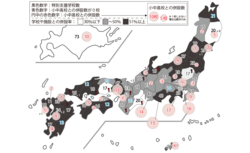
KAMEYA, Emiko
| Affiliation | Department of Architecture and Civil Engineering |
|---|---|
| Title | Associate Professor |
| Fields of Research | Architectural Planning/Housing and Welfare |
| Degree | Ph.D. (Engineering)(Tohoku Univ.) |
| Academic Societies | Architectural Institute of Japan/Japan Socio-Gerontological Society/The Japan Society Of Home Economics/Japan Institute of Healthcare Architecture |
| kameya.emiko.ec Please append "tut.jp" to the end of the address above. |
|
| Researcher information URL(researchmap) | Researcher information |
Research
We study living environments that do not leave minorities behind. Architecture plays a major role as a public object, and it is inevitable that average or general characteristics are emphasized. However, if the average of the characteristics of various people is considered "general," it means creating something that is somehow easy for everyone to use, but at the same time inconvenient for everyone. A living environment that does not leave minorities behind should be patient and tolerant of someone else's inconvenience, and one that properly reaches a specific "someone" rather than an absentee "average" person. We conduct our research while aiming to create a comfortable space for each of us without receiving only the idea of "general".
Theme1:Living environment of SDGs
Overview
I have studied facilities for poverty support, educational environments for handicapped children, educational environments for students not attending school, and living environments for people with intractable diseases. All of these people and all of these environments are institutional environments that are treated as special solutions, not general solutions. I conduct my research while considering how to provide a flat environment without regarding them as “special people. Does providing a special environment for special people constitute “consideration”? I believe that this is a difficult question that society as a whole must consider.
Selected publications and works
1)Emiko KAMEYA,Case Study on the Changing Daily Living and the House Adaptation of the ALS patient’s family during Home Recuperation and after the Patient’ Death at home, Journal of home economics , No.70(7), pp.425-436, 2019.7
2)Emiko KAMEYA, etc.,A STUDY ON SPATIAL CHARACTERISTICS AND LIVING ENVIRONMENT FOR RESIDENTS IN RELIEF FACILITIES(PART 1): CHANGES IN THE USE OF ROOMS AND DAILY LIFE DURING THE COVID-19 PANDEMIC, The Architectural Institute of Japan’s Journal of Architecture and Planning , No.86(787), pp.2223-2233, 2021.9
3)Emiko KAMEYA, etc.,RESEARCH ON THE CHARACTERISTICS AND COLLABORATION OF SPECIAL-NEEDS SCHOOLS ATTACHED TO ELEMENTARY, MIDDLE, AND HIGH SCHOOLS AND FACILITY SHARING, The Architectural Institute of Japan’s Journal of Architecture and Planning , No.88(811), pp.2476-2486, 2023.9
Keywords
Theme2:Research on architectural planning history of medical facilities
Overview
I am researching the spatial configuration of tuberculosis sanatoriums that no longer exist.
I am analyzing the treatment environment of people in the past, analyzing old architectural drawings from a time when medical and architectural technology had not yet been developed. Hand washing and social distance were encouraged during the COVID- 19 epidemic, and history shows that they were also practiced during the TB epidemic as a national measure. It seems that the “new lifestyle” of the coronary disaster was not new. I have been reading through old documents to identify the lifestyle and architecture of the time.
Although it is said that we are learning from the past, it seems that in recent years, due to the remarkable progress of science and technology, the times are moving so fast that we are advancing without warming up to the old. Archival research has the potential to become a benchmark for them.
Selected publications and works
1)Emiko KAMEYA and Kentaro SAKAINO, THE HISTORY OF ARCHITECTURAL PLANNING OF SANATORIUMS FOR TUBERCULOSIS IN MODERN TIMES (PART 1): ESTABLISHERS AND ARCHITECTURAL CHARACTERISTICS IN EACH PERIOD, The Architectural Institute of Japan’s Journal of Architecture and Planning , No.88(804), pp.392-403, 2023.2
Keywords
Title of class
Bachelor Classroom:Introduction to Regional Planning(B15530050),Architechture Planning(B15621050)
Bachelor Design :Architectural Design Workshop 1(B15510130),Design Workshop 4(B15621080),Design Workshop 6(B15621160)
Master Classroom:Advanced Architechtural Design(D35030040)
Others (Awards, Committees, Board members)
【Awards】
1) 2006, Research Scholarship Award, Japan Housing Research Foundation
2) 2007, The Architectural Institute of Japan, Incentive Award
3) 2014, Research Award, Foundation for Housing Research, Japan
4) 2020, Chubu Branch of the Japan Society of Home Economics, Incentive Award for Outstanding Papers, etc.
【Directors】
Director, Social Welfare Corporation (from May 2025)



